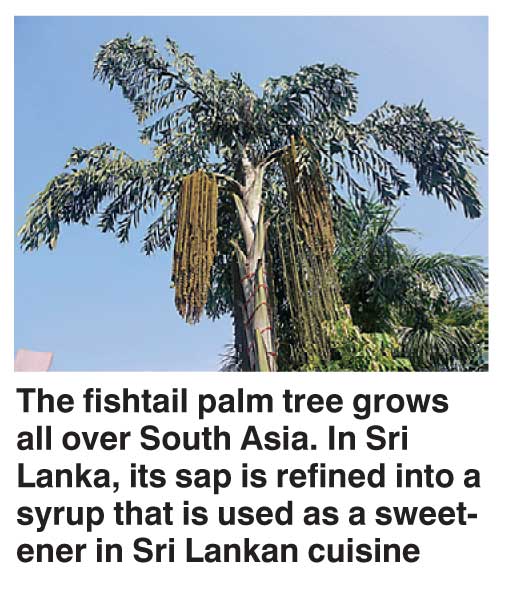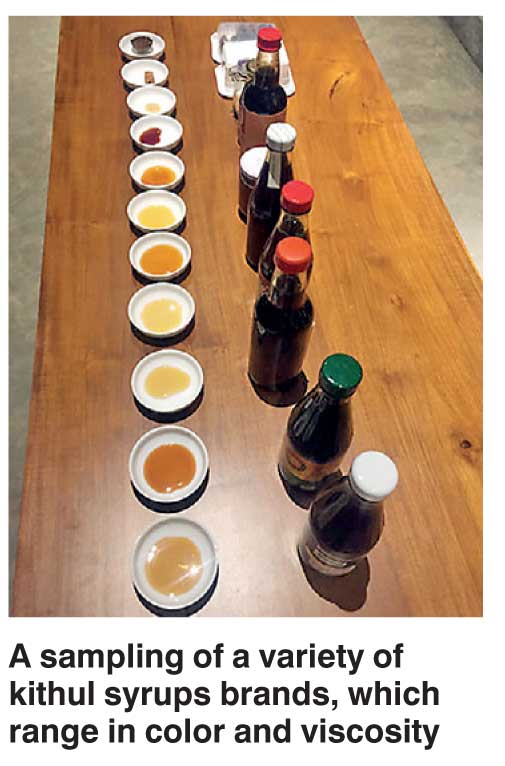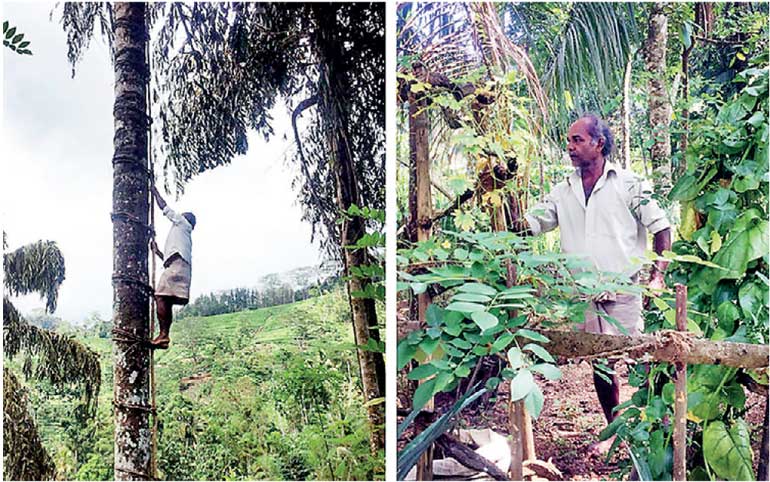Wednesday Apr 23, 2025
Wednesday Apr 23, 2025
Monday, 30 January 2017 00:13 - - {{hitsCtrl.values.hits}}
 By Vidya Balachander
By Vidya Balachander
The story of Sri Lanka’s most beloved sweetener starts with the kithul, or fishtail, palm tree and a tapper, like 58-year-old Amuvita Gamage Dayasena.
The slightly built farmer sharpens his knife on the fallen branch of a tree and climbs up a wooden lattice that he has tied to one side of a kithul tree in his garden. Within minutes, he is on the top of the nearly 40-foot-tall tree, making sharp incisions at the base of a cluster of flowers that droop down from a branch like a bunch of grapes. Dayasena ties a jute sack to the base of the cluster to collect droplets of sap trickling down.
He will collect the sap over several days and boil it down over an open wood fire, until it reduces to a sticky and intensely sweet syrup the color and thickness of honey. This is kithul syrup, or kithul peni, as it’s called locally. At its purest, it boasts woody, floral, smoky and even savory notes and is used widely in Sri Lankan cuisine. It is also further boiled down and set into molds, usually fashioned out of empty coconut shells, to make little blocks of hakuru, or jaggery, a partially refined palm sugar used all over the island. Despite its vital place in the Sri Lankan pantry, kithul syrup is becoming something of a vanishing treasure. And tappers are increasingly turning to other, more lucrative professions. Dayasena too has other sources of income - two acres of farmland on which he cultivates tea and a flourishing home garden, where he grows a variety of food crops like pepper, pineapples and vegetables.
The fishtail palm, also known locally as the jaggery palm, is abundant all over Sri Lanka.
It’s been used by the island’s residents since ancient times.
Nineteenth century historians mention its uses in Ceylon (as the country was known until its name was officially changed to Sri Lanka in 1972) in their writings.
“This magnificent palm... has found a place in the oldest records of Ceylon, sacred and historical,” noted T. B. Pohath-Kehelpannala, a local historian and author, in an essay called The Kitul And Its Uses, published in 1898.
It was once prized for its strong timber; thalapa, a kind of nutritious gruel that was made from its tender leaves; and also for the mildly alcoholic toddy, or palm wine, made from the sap.
These days though, in addition to toddy, the fishtail palm is best known as the source of kithul jaggery and syrup. Both have treasured places in Sri Lankan cuisine. “Hakuru or jaggery is what we use in place of sugar in everyday life,” says Narmada Mueller, a publisher and entrepreneur based in Colombo. “For instance, it’s common for a cup of black tea to be served with a piece of jaggery.”
The syrup is often used as a sweetener in traditional desserts, like kiri peni, a creamy buffalo milk yogurt with palm syrup drizzled on top. “Sri Lankans have a big sweet tooth and kiri peni has always been our go-to dessert,” says Mueller. The syrup is also used as a sweetener in Sinhalese and Tamil New Year treats like kavum, a deep-fried sweet made of rice flour and coconut milk, and aluwa, a flat, diamond-shaped sweet made of rice flour, cashew nuts and kithul syrup.
 But a host of factors have led to the recent scarcity in this once-abundant sweetener. One of them is rapid destruction of rainforests, which provide a particularly favorable environment for kithul trees. The forests are being cleared partly to make room for tea and rubber plantations.
But a host of factors have led to the recent scarcity in this once-abundant sweetener. One of them is rapid destruction of rainforests, which provide a particularly favorable environment for kithul trees. The forests are being cleared partly to make room for tea and rubber plantations.
In Dayasena’s village of Kiriweldola, which is situated close to the Sinharaja Forest Reserve, a narrow strip of rainforest that’s also a UNESCO World Heritage Site, most families now cultivate tea on the small plots of land they own.
“Thirty years earlier, their main livelihood was kithul tapping and collecting non-timber forest products, like mushrooms and medicinal plants,” says Ajith Thennakoon, a veteran development professional and field director of Sewalanka Foundation, a local non-profit working on projects to empower rural communities. “Now, their lifestyle has changed completely.”
Kithul cultivation and tapping is a risky, high-investment proposition that takes time to yield returns. If the flowers grow well, Dayasena can earn about $200 from each tapping, by selling the syrup and jaggery. He has nine kithul trees on his land.
“But the tree dies after it flowers once or twice, and the amount of sap it produces can vary,” he says. In comparison, the tea, pepper and other crops he cultivates promise a much more reliable source of income.
In addition to these troubles, Sri Lanka’s kithul industry has also been affected by changing social values. More and more families want their children to pursue professions perceived as being more stable and respectable, such as Government or bank jobs, leading to a growing dearth of skillful tappers.
The kithul palm tree demands a close and intuitive understanding of its various stages of flowering and sap production. It can take up to 15 years of constant care for the palm to flower and produce sap, and it is also sensitive to changes in wind and rain. Tappers are privy to a wealth of traditional knowledge about the tree and tapping techniques that are passed down through the generations, says Thennakoon. “This knowledge is threatened because the younger generation doesn’t want to climb trees.”
All these factors combined have led to a decline in the production of fishtail palm syrup and jaggery, despite sustained demand from the local market. Adulteration is rife and the quality of the syrup has suffered.

“It takes a lot of work to be able to get the sap and boil it down,” says Amanda Kiessel, founder of the Good Market, a marketplace that brings together a large number of socially conscious, organic and fair trade enterprises under one umbrella. The syrup is expensive, she says, and it’s common for tappers to add sugar or water it down to earn a little extra money.
For the moment, initiatives like the Good Market are giving this artisanal product a much-needed stamp of quality. The kithul brands sold under the Good Market umbrella are all-natural – they don’t contain artificial food additives – and sourced using fair trade practices. The close relationship between vendors and customers at the weekly market ensures that quality is usually maintained, says Kiessel.
Kithul syrup and jaggery are also getting a boost from a new crop of local chefs and entrepreneurs who are taking a renewed pride in indigenous ingredients. At Kopi Kade, a minimalist coffee shop in Colombo, the country’s capital, the menu includes a salted kithul ice cream and an affogato sweetened with salted kithul syrup.
“It has been totally rewarding for me to work with local ingredients like kithul,” says Nimeshan Namasivayam, the proprietor of Kopi Kade. His latest experiment involves using kithul syrup to make a batch of kombucha.
The syrup is used as a replacement for refined sugar in smoothies, cakes and other baked goods at Cafe Kumbuk, a popular restaurant that emphasizes local, organic and seasonal produce. The syrup is also served as an alternative to honey or maple syrup, drizzled on top of Kumbuk’s pancake stacks.
However, rebranding this already popular ingredient as hip may not be enough to save it from disappearing, says Thenakkoon. What’s likely to have a bigger impact is finding ways to instill a sense of pride in the traditional occupation of palm tapping, by offering it as a vocational skill at universities, he says.
For Dayasena, who maintains meticulous records of his monthly earnings, it’s clear that kithul tapping is an unreliable source of income. He is keener to show off his recent success with organic tea cultivation, and the organic pepper that is drying in his front yard.
“It takes hours of boiling to produce this bottle of syrup,” he says, as he pours some of the thick, amber liquid into a glass for me to taste. The uncertain future of this much loved sweetener lies in that bittersweet truth.
(Note: This article was carried in the Daily FT excluding the byline and source. We wish to apologise to all for any inconvenience caused.)
Discover Kapruka, the leading online shopping platform in Sri Lanka, where you can conveniently send Gifts and Flowers to your loved ones for any event including Valentine ’s Day. Explore a wide range of popular Shopping Categories on Kapruka, including Toys, Groceries, Electronics, Birthday Cakes, Fruits, Chocolates, Flower Bouquets, Clothing, Watches, Lingerie, Gift Sets and Jewellery. Also if you’re interested in selling with Kapruka, Partner Central by Kapruka is the best solution to start with. Moreover, through Kapruka Global Shop, you can also enjoy the convenience of purchasing products from renowned platforms like Amazon and eBay and have them delivered to Sri Lanka.
Discover Kapruka, the leading online shopping platform in Sri Lanka, where you can conveniently send Gifts and Flowers to your loved ones for any event including Valentine ’s Day. Explore a wide range of popular Shopping Categories on Kapruka, including Toys, Groceries, Electronics, Birthday Cakes, Fruits, Chocolates, Flower Bouquets, Clothing, Watches, Lingerie, Gift Sets and Jewellery. Also if you’re interested in selling with Kapruka, Partner Central by Kapruka is the best solution to start with. Moreover, through Kapruka Global Shop, you can also enjoy the convenience of purchasing products from renowned platforms like Amazon and eBay and have them delivered to Sri Lanka.